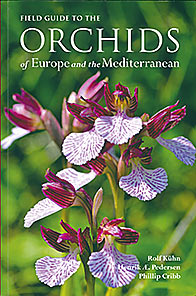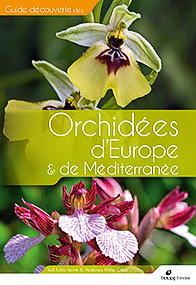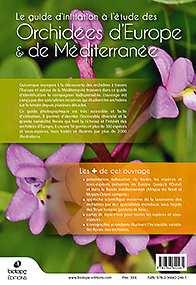Field Guide to the Orchids
of Europe and the Mediterranean.
by/door Rolf Kühn, Henrik A. Pedersen & Philip Cribb.
A Kew Publishing edition, Royal Botanic Gardens, Kew.
430 pp., 2019, Many color photos, distribution maps for each species, subspecies, variety/
zéér veel kleurenfoto’s, een verspreidingskaartje voor elke soort, ondersoort en variëteit.
Formaat: 15,7 x 23,4 centimeter.
ISBN: 978-1-84246-669-8; e-Book 978-1-84246-670-4
Édition francophone :
Guide découverte des Orchidées d’Europe et de Méditerranée.

A foreword has been written by Richard Bateman, the chairman of the "Hardy Orchid Society" and "Honorary Research Associate at the Royal Botanic Gardens, Kew".
In the ‘Preface’ (p. IX-X), the authors point to the numerous orchid field guides containing a multitude of names for the same orchid species. A reason for this is the species concept used by the various authors. One consequence was a controversy about the correct naming of many a taxa. This is especially the case for species in the genera Ophrys, Dactylorhiza, Epipactis and Serapias.
The authors of this field guide have attempted a scientifically classification and nomenclature with an emphasis on the natural variability found in many species. The information that is given in the chapter ‘Taxonomy of European Orchids’ (p. 27-33) is very important here. The taxonomic concepts of genus, species, subspecies, variety and form are clearly explained. They form the guideline for the naming of species in this field guide. In this chapter the variability within one species is beautifully illustrated (p. 29: Ophrys fuciflora subsp. fuciflora).
Prior to this chapter, in ‘Introduction’ (p. 1-25), the authors discuss the orchid plant, the structure of the flowers, the pollination, the ecology (climate, substrate, pH values of the growing sites, etc.), the various orchid habitats, conservation and classification.
Under ‘How to use this Field Guide’ (p. 35), the authors make clear that this guide is primarily a photographic guide that, as far as possible, shows the variation within each taxon (species, subspecies and variety). With the help of photos a species can be identified in the field but, explain the authors, if a flower in nature does not really matches with an illustration in this guide, this does not mean that one has, for example, found a hybrid. For that reason, next to the most variable taxa, several photographs have been published.
For the nomenclature this guide follows largely the ‘World Checklist of Flowering Plant Families’ (http://wcsp.science.kew.org/home.do).
From p. 37 on the chapter ‘Genera and Species’ (p. 37-383) shows all species, subspecies and varieties. Each genus is briefly but clearly described. Each species (species), subspecies (subspecies) and variety is presented with photos, short texts, information about the distribution, the habitat, the flowering period and a short description (‘Distinguishing features’) and beside each taxon a distribution map.
Illustrations of 60 natural hybrids with a short note follow the ‘Genera and Species’ chapter (p. 384-407).
The book concludes with ‘Acknowledgments’ (p. 409), a very short ‘Bibliography’ (p. 411), an ‘Index of Scientific Names’ (p. 413-427) and an ‘Index of Common’ Names' (pp. 429-430).
Conclusion.
This photographic field guide leads us with more than 2,000 photos (300 taxa) along all orchid species within 30 genera that live in Europe and the Mediterranean area. The authors were guided by the latest scientific findings to clarify the naming of the various species with emphasis on the natural variety within each species.
I think the authors achieved what they had in mind with this guide although the naming of species within the genera Ophrys, Dactylorhiza, Epipactis and Serapias is and will always be a bit ambiguous, not easy.
Especially because of the many photos, this field guide is a useful tool and definitely recommended.
top
Een voorwoord is geschreven door Richard Bateman, de voorzitter van de ‘Hardy Orchid Society’ en ‘Honorary Research Associate at the Royal Botanic Gardens, Kew’.
In hun voorwoord (Preface: p. IX-X) wijzen de auteurs op het grote aantal aan orchideeënveldgidsen met daarin een veelheid aan verschillende namen voor dezelfde orchideeënsoorten. Een oorzaak hiervoor is het species-concept dat door de diverse auteurs gehanteerd werd. Een gevolg was dat er toch wel wat controverse ontstond over de juiste naamgeving van menig taxon. Dit is vooral het geval voor soorten in de genera Ophrys, Dactylorhiza, Epipactis en Serapias.
De auteurs van deze veldgids schrijven dat ze geprobeerd hebben een zo wetenschappelijk mogelijke classificatie en nomenclatuur aan te bieden met de nadruk op de natuurlijke variabiliteit die in veel soorten gevonden wordt. Hierbij is de informatie zeer belangrijk die in het hoofdstuk ‘Taxonomie of European Orchids’ (p. 27-33) geven wordt. De taxonomische concepten genus, species, subspecies, variëteit en vorm worden duidelijk uitgelegd. Ze vormen de leidraad voor de naamgeving van de soorten in deze veldgids. In dit hoofdstuk is de variabiliteit binnen één species mooi geïllustreerd (p. 29: Ophrys fuciflora subsp. fuciflora).
Voorafgaand aan dit hoofdstuk bespreken de auteurs in ‘Introduction’ (p. 1-25) de orchideeënplant, de structuur van de bloemen, de bestuiving, de ecologie (klimaat, substraat, pH waarden van de groeiplaatsen, enzovoort…), de diverse orchideeënhabitat, de instandhouding en de classificatie.
In ‘How to use this Field Guide’ (p. 35) maken de auteurs duidelijk dat deze gids hoofdzakelijk een fotografische gids is die in de mate van het mogelijke de variatie toont binnen elk taxon (species, subspecies en variëteit). Aan de hand van de foto’s kan in het veld een soort geïdentificeerd worden en, maken de auteurs duidelijk, als een bloem in de natuur niet echt overeenkomt met een afbeelding in deze gids betekent dat niet dat je bv. een hybride gevonden hebt. Om die reden zijn naast de meest variabele taxa meerde foto’s gepubliceerd.
Voor de naamgeving in deze veldgids wordt hoofdzakelijk de nomenclatuur van de ‘World Checklist of Flowering Plant Families’ gevolgd (http://wcsp.science.kew.org/home.do).
Vanaf p. 37 komen in het hoofdstuk ‘Genera and Species’ (p. 37-383) per genus alle species, subspecies en variëteiten aan bod. Elke geslacht wordt kort maar duidelijk voorgesteld. Elke soort (species), ondersoort (subspecies) en variëteit wordt voorgesteld met foto’s, korte teksten, info over de verspreiding, de habitat, de bloeiperiode en een korte beschrijving (‘Distinghuising features’). Bij elk taxon staat ook een verspreidingskaartje.
In deze gids zijn ook een 60-tal natuurhybriden afgebeeld en kort besproken (p. 384-407).
Het boek sluit af met ‘Acknowledgements’ (Dankzeggingen: p. 409), een toch wel zéér korte ‘Bibliography’ (p. 411), een ‘Index of Scientific Names’ (p. 413-427) en een ‘Index of Common Names’ (p. 429-430).
Conclusie.
Deze fotografische veldgids leidt ons met meer dan 2.000 foto’s (300 taxa) langs alle orchideeënsoorten binnen 30 orchideeëngeslachten die in Europa en het Mediterrane gebied voor komen. De auteurs lieten zich leiden door de laatste wetenschappelijke bevindingen om klaarheid te brengen in de naamgeving van de diverse soorten met nadruk op de veel voor komende natuurlijke variëteit.
Ik vind dat de auteurs in hun vooropgezet doel geslaagd zijn al blijft de naamgeving bij soorten binnen de genera Ophrys, Dactylorhiza, Epipactis en Serapias niet altijd eenvoudig noch eenduidig.
Vooral omwille van de zeer vele foto’s is deze veldgids zeker en vast nuttig én een aanrader.


Guide découverte
des Orchidées d’Europe et de Méditerranée.
par Rolf Kühn, Henrik A. Pedersen & Philip Cribb.
Biotope Éditions (www.biotope-editions.com)
ISBN 978-2-36662-246-1
Un avant-propos a été rédigé par Richard Bateman, président de la Hardy Orchid Society et associé de recherche honoraire au Royal Botanic Gardens, Kew.
Dans leur Préface les auteurs soulignent qu’il y a un grand nombre de guides de découverte des orchidées contenant une multitude de noms différents pour la même espèce d'orchidée. Ceci explique concept utilisé par les différents auteurs pour ce guide ci. Par conséquence, une controverse a surgi au sujet de la dénomination correcte de nombreux taxons. C'est notamment le cas pour les espèces des genres Ophrys, Dactylorhiza, Epipactis et Serapias.
Les auteurs de ce guide de terrain écrivent qu'ils ont tenté de fournir la classification et la nomenclature la plus scientifique possible en mettant l'accent sur la variabilité naturelle observée chez de nombreuses espèces. Les informations données dans le chapitre «Taxonomie des orchidées européennes» sont très importantes. Les concepts taxonomiques de genre, d'espèce, de sous-espèce, de variété et de forme sont clairement expliqués. Ils guident la dénomination des espèces dans ce guide de terrain. Dans ce chapitre, la variabilité au sein d'une même espèce est bien illustrée (p.ex. Ophrys fuciflora subsp. Fuciflora).
Avant ce chapitre dans une introduction, les auteurs décrivent la plante orchidée, la structure des fleurs, la pollinisation, l'écologie (climat, substrat, pH du biotope, etc…), les divers habitats des orchidées, leur conservation et leur classification.
Dans «Comment utiliser ce guide de terrain» les auteurs précisent que ce guide est avant tout un guide photographique montrant, dans la mesure du possible, la variation au sein de chaque taxon (espèce, sous-espèce et variété). À partir des photographies, une espèce peut être identifiée sur le terrain et, précisent les auteurs, si une fleur dans la nature ne correspond pas vraiment à une image de ce guide, cela ne signifie pas que vous avez trouvé un hybride, par exemple. Pour cette raison, plusieurs photos ont été publiées pour des taxons les plus variables.
La nomenclature de la «World Checklist of Flowering Plant Families» est principalement suivie pour la dénomination des espèces (http://wcsp.science.kew.org/home.do).
Dans le chapitre «Genres et espèces» toutes les espèces, sous-espèces et variétés sont discutées par genre. Chaque genre est présenté : brièvement mais clairement. Chaque espèce, sous-espèce et variété est présentée avec des photos, des textes courts, des informations sur la répartition, l'habitat, la période de floraison et une brève description. Avec chaque une carte de répartition est également incluse taxon.
Dans ce guide, une soixantaine d'hybrides naturels sont également décrits et brièvement discutés.
Le livre se termine par «Remerciements», une très courte «Bibliographie», un «Index des noms scientifiques» et un «Index des noms communs».
Conclusion.
Ce guide photographique de terrain nous conduit avec plus de 2000 photos (300 taxons) le long de toutes les espèces d'orchidées au sein de 30 genres d'orchidées trouvés en Europe et dans la région méditerranéenne. Les auteurs ont été guidés par les dernières découvertes scientifiques pour clarifier la dénomination des différentes espèces en mettant l'accent sur la variété naturelle commune.
Je pense que les auteurs ont atteint leur objectif prédéterminé, bien que la dénomination des espèces des genres Ophrys, Dactylorhiza, Epipactis et Serapias ne soit pas toujours simple ni sans ambiguïté.
Surtout à cause des nombreuses photos, ce guide de terrain est certainement utile et recommandé.